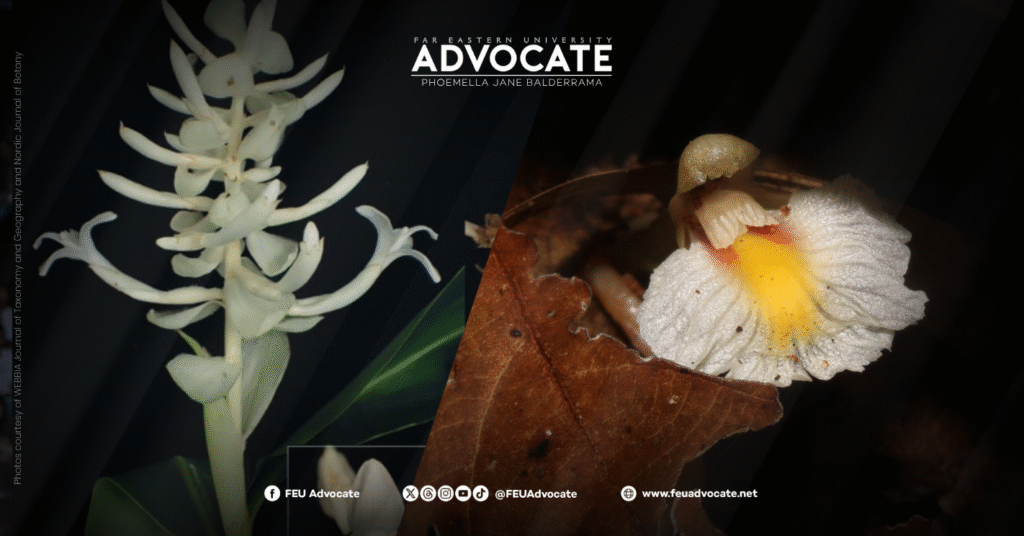
FEUCSO, student-led orgs nanawagan sa COMELEC: voter’s registration, palawigin
- September 03, 2021 09:22
FEU Advocate
July 11, 2025 17:50

By Mark Vincent A. Durano
Far Eastern University Herbarium researchers Rudolph Valentino Docot and Lyle Christian Santiago contributed to two scientific publications this year, discovering two species of ginger both inside and outside the Philippines.
Docot, a faculty from the Department of Biology, led the exploration of Alpinia arachniformis A.D. Poulsen in Papua New Guinea while Santiago worked with Docot for the discovery of Amomum zamboangense sp. nov. in Mindanao.
New local species
The two Tamaraw taxonomists worked with Kean Roe Mazo and Mark Gregory Rule from the Mindanao State University, Thomas Haevermans from France, and Axel Dalberg Poulsen from Scotland for their publication ‘The phylogenetic placement of a new species of Amomum (Zingiberaceae) from the Philippines.’
The paper was published under the Nordic Journal of Botany last May 14.
During a recent fieldwork in the Pasonanca Natural Park in Zamboanga City last November 2023, Docot and Santiago’s team gathered Amomum samples that resembled the Bornean endemic Amomum stenosiphon.
In an interview with FEU Advocate, Research Associate Santiago shared that the new Amomum was discovered accidentally while resting in the area.
“‘Yung kasama namin umupo siya sa isang nakatumbang kahoy kasi nagpapahinga na rin kami. Tapos sumilip lang siya sa likod niya pagtingin niya may nakita siyang parang hindi pa naming kilalang species ng ginger (Our member sat on a laid down wood because we were also resting. Then, he peeked at his back, he saw a species of ginger that we did not know),” he said.
The exploration was funded and under the Project Scope of the FEU University Research Center.
Through a phylogenetic analysis based on ITS trnK/matK sequences, the Philippine collections formed a monophyletic group indicating that they came from the same ancestors. However, they did not group with A. stenosiphon in the ITS tree.
An autapomorphic site or unique trait was also found in the ITS region for the Philippine samples.
Since the discovery was made in Zamboanga City, the team gave the specific name zamboangense.
The researchers distinguished the local species from A. stenosiphon by their longer petioles or leafstalk, more narrow and ovate laminae or leaf blades, and fewer flowers of three per flowering shoot.
Additionally, the team’s discovery marked the second species of Amomum s.s. in the country after the Amomum dealbatum was recorded in Bukidnon last 2014.
The new species inhabits semi-shaded secondary forests, specifically in the southwest portion of the Pasonanca Natural Park.
It is provisionally listed as Endangered according to the IUCN Red List.
Overseas discovery
This time abroad, the FEU faculty had his first publication in 2025 for his research ‘Alpinia arachniformis (Zingiberaceae): a new species from New Ireland, Papua New Guinea.’ The publication was issued under the WEBBIA Journal of Taxonomy and Geography last April 17.
He worked with Bernard Sule from Papua New Guinea, Haevermans, and Poulsen since 2013 for the paper exploring the ginger flora in the Bismarck Archipelago.
They collected the ginger genus Alpinia and noticed some samples with elongated cincinni or monochasium with successive branches borne on opposite sides. The laxly arranged axis is composed of bracteoles or small leaf-like structures.
With its spider-like appearance, the researchers chose the epithet arachniformis.
Docot’s team used an Internal Transcribed Spacer (ITS), linking the new species to other species such as A. oceanica. However, they are differentiated by their number of cincinni and linear labellum.
Locally named as gorgor or ngu-ngau, A. arachniformis is endemic to the province of New Ireland but has also been documented in New Hanover and grows in lowlands and coastal areas.
According to the International Union for Conservation of Nature (IUCN) Red List, A. arachniformis is provisionally assessed as Vulnerable, subject to threats such as logging and conversion of forests into agricultural and residential gardens.
Contributions to taxonomy
In the same interview, Santiago expressed his joy in discovering the new species and sharing it to a broader audience.
“Sa Philippines kasi, we have so much to explore particularly in terms of our plants or flora. Masaya kasi we were able to discover, and of course, mas masaya kasi now madali na namin siyang ma-i-she-share through social media, and of course, at the rise of the internet,” he added.
The research associate also encouraged others to put the spotlight on other research on flora.
“Sana bigyan din natin ng pansin ‘yung mga research particularly on plants na kahit hindi siya new species, as long as may novelty doon, sana mapansin din, (I hope we can give attention to research particularly on plants even if it is not a new species, as long as there is novelty, I hope it can be noticed too),” Santiago stated.
He hopes that funding on Botanical research and explorations will also continue to produce and discover more.
Together with Haevermans and Poulsen, Docot also released his third paper this year, ‘Is Alpinia luteocarpa the correct scientific name for the ornamental red bamboo ginger?’ correcting the name for the ornamental red bamboo ginger as Kolowratia eruciformis, initially known as Alpinia luteocarpa.
It also described another ginger species, Languas scorpioidea, as endemic to Mindanao.
In 2020, the two Tamaraw taxonomists also had a research publication, documenting the discovery of two ginger species Boesenbergia eburnea Docot and Boesenbergia leonardocoi Funak. & Docot in Palawan.
They also worked together in unravelling the Plagiostachys parviflora (C.Presl) Ridl. whose species remained doubtful since 1827 during the Malaspina expedition which was published last June 2024.
Docot also had a discovery of a ginger species Plagiostachys lourdesian which is endemic to the country in the Mount Timolan Protected Landscape, published in 2020. It was named after University Chair Emeritus Lourdes Montinola, the daughter of late University Founder Nicanor Reyes Sr.
He has also contributed in the discovery of other ginger species such as Wurfbainia rubrofasciata in 2023, an orchid species Orchipedum shareeanniae in 2022, and a begonia species Begonia makuruyot in 2020.
- With reports from Cassandra Luis J. De Leon
(Photos courtesy of WEBBIA Journal of Taxonomy and Geography and Nordic Journal of Botany)









